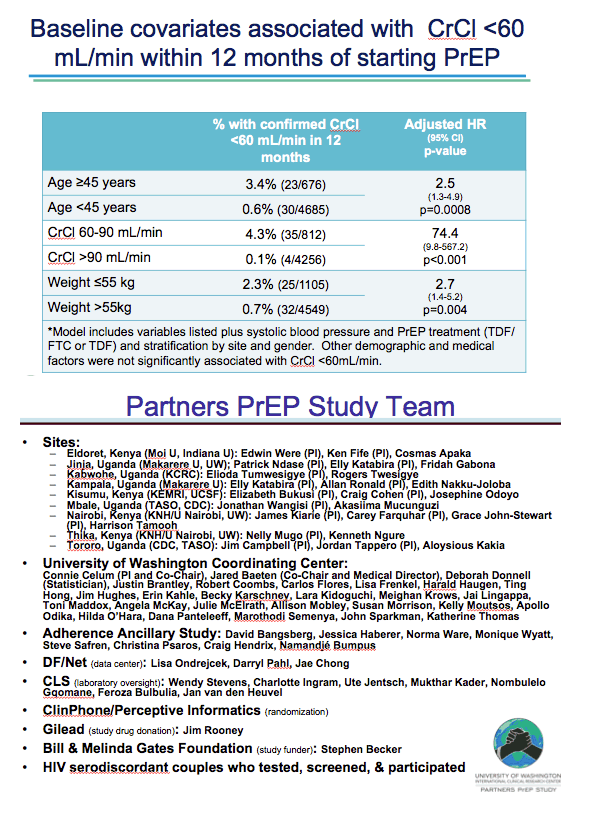 |
 |
 |
| |
Optimizing the frequency of kidney safety monitoring in HIV-uninfected persons using daily oral tenofovir disoproxil fumarate pre-exposure prophylaxis
|
| |
| |
Reported by Jules Levin
Durban 2016 July 18-22
Presenter
Renee Heffron
Authors
K. Mugwanya1, R. Heffron1, C. Wyatt2, N. Mugo3, C. Celum1, J. Kiarie4, E. Katabira5, A. Ronald6, J. Baeten1, for the Partners PrEP Study and Partners Demonstration Project Teams
Institutions
1University of Washington, Global Health, Seattle, United States, 2Icahn School of Medicine at Mount Sinai, Medicine, New York, United States, 3Kenya Medical Research Institute, Nairobi, Kenya, 4University of Nairobi, Obstetrics and Gynecology, Nairobi, Kenya, 5Makerere University, Medicine, Kampala, Uganda, 6University of Manitoba, Winnipeg, Canada
webcast: https://www.youtube.com/watch?v=RtVaxIK3gh4



ABSTRACT
Background: Optimal kidney safety monitoring is a key knowledge gap for wide-scale implementation of tenofovir-based pre-exposure prophylaxis (PrEP) for HIV prevention. We compared 6-monthly to 3-monthly kidney monitoring for the occurrence of clinically relevant decline in creatinine clearance (CrCl; < 60 mL/minute).
Methods: Data were from two prospective PrEP studies in Kenya and Uganda: the Partners Demonstration Project (n=955), a recently completed open-label study that used 6-monthly serum creatinine monitoring to estimate creatinine clearance, and the Partners PrEP Study, a placebo-controlled trial that used 3-monthly monitoring (n=4404 receiving PrEP, n=1573 receiving placebo). CrCl ≥60 mL/minute was required for enrollment in both studies.
Results: With 6-monthly monitoring, the cumulative proportion of participants with unconfirmed CrCl < 60 mL/minute was 0.7% at Month 6 and 1.1% at Month 12, affecting 10 (1%) participants; 2 of these (0.2% overall) had CrCl < 60 mL/minute confirmed on repeat testing, both at Month 6. With quarterly monitoring, the cumulative proportion of participants with unconfirmed CrCl < 60 mL/minute was 1.4% at Month 3, 2.0% at Month 6, and 2.7% at Month 12, affecting 120 (2.7%) participants; 29 of these (0.7%, overall) had CrCl < 60 mL/minute confirmed on repeat testing [cumulative proportion: 16 (0.4%), 21 (0.5%), and (0.7%) at Months 3, 6, and 12, respectively]. The corresponding cumulative frequency of confirmed CrCl < 60 mL/minute in the placebo group was 0.3% at Month 3 and 0.3% at Month 6. Of the 29 participants experiencing confirmed declines in the Partners PrEP Study, 28 (97%) had baseline CrCl 60-90 mL/minute, 19 (66%) were aged ≥45-years, and 16(55%) had baseline weight ≤55 kg (adjusted p< 0.05).
Conclusions: In these two large cohorts of HIV-uninfected persons using PrEP, the occurrence and pattern of clinically relevant decline in CrCl were not qualitatively different based on quarterly or 6-monthly CrCl monitoring. Most measurements of CrCl < 60 mL/minute did not confirm on repeat testing. These data suggest that 6-monthly CrCl monitoring could be equally safe and require fewer resources for a majority of persons receiving PrEP, with more frequent monitoring potentially indicated for those with specific risk factors (older age, lower baseline CrCl, lower weight).




|
| |
|
 |
 |
|
|